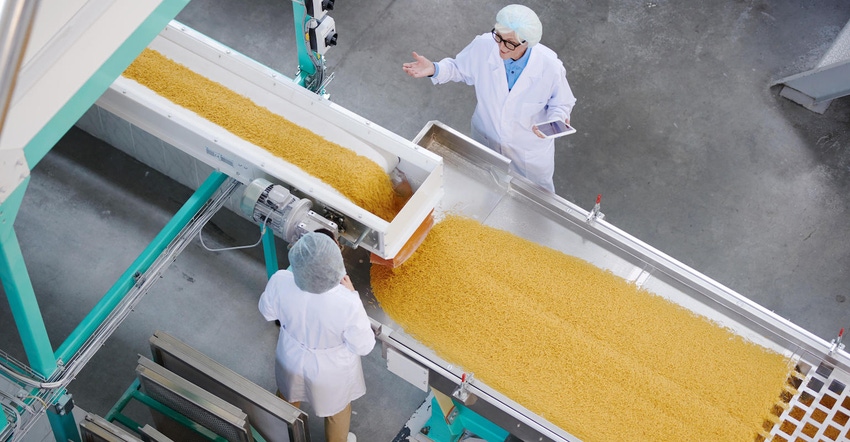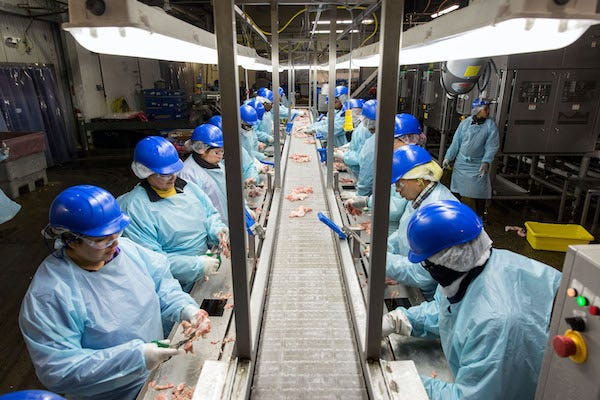3 Major Issues Food Manufacturers Will Face in 2022
Powder & Bulk Solids identified three main areas that will impact the food and beverage manufacturing industry next year.

As 2021 draws to a close, the food and beverage manufacturing industry remains in a highly volatile environment. Inflation is accelerating across the economy, labor is in short supply, transportation and shipping costs have skyrocketed, and raw materials have become more expensive. All of this has created some serious headaches for consumers and suppliers alike.
Despite these headwinds, the industry’s major players are charting a course ahead with an eye toward mitigating some of the risks that 2022 may present. Approaches to overcoming these issues differ, but a review of some of recent earnings statements and calls from some of America’s top food and beverage companies reveals three common pain points the industry will address in the year to come.
Labor Shortages to Wear On
Over 130,000 jobs in the US consumer packaged goods industry – which includes food and beverage products – were unfilled as of October 2021, according to a recent Consumer Brands Association analysis of US Bureau of Labor Statistics (BLS) employment data. The industry organization’s chief executive officer, Geoff Freeman, said this month that vaccine requirements set to take effect in some American workplaces at the start of 2022 could hinder the food and beverage industry’s efforts to attract talent.
“We are experiencing a supply chain crisis unlike anything our industry has seen before and the labor shortage is at the top of our list of concerns,” said Freeman in a statement. “While fully supportive of increasing vaccination rates, we are holding our breath that the new vaccine requirements don’t further erode the essential workforce and ask the Biden administration to partner with industry to track progress as we approach the January 4 deadline.”
While vaccination mandates may be playing some role in the shortage, a variety of other long-standing factors are at play that the industry has struggled with for decades, including low wage growth for production staff, immigration issues, and a short supply of skilled workers. Nonetheless, the labor disruptions wrought by COVID-19 are unprecedented and some observers see these problems continuing into the coming year.

“The labor challenges that we’re seeing are certainly tougher than I remember,” Campbell Soup Co. chief executive officer and director Mark A. Clouse said in September. The company’s Q4 2021 earnings call noted that that the availability of workers is expected to “remain highly volatile” during its fiscal year 2022.
Attracting new workers and strengthening relationships with existing employees was top of mind for Conagra Brands president and chief executive officer Sean Connolly in a discussion with investors last month. “It’s a tight labor market, and it takes a lot of ingenuity and creativity and effort to attract and retain employees to the best of our ability,” the executive stated. “So, we’re obviously always trying to cultivate the strongest possible relationships with our employees so that they feel good about coming to work every day.”
Chocolate maker Hershey Co. intensified its recruitment efforts during 2021 as well as its efforts to identify and respond to the needs of its existing workforce. “We know that we have highly competitive wage rate. We have excellent benefits and we routinely benchmark all of that, “Melissa A. Poole, vice president of investor relations for Hershey, said in the firm’s Q3 earnings call, “but we’re also very focused on the softer factors that are very important to our employees and that includes, especially in these times of global supply chain challenge, work life balance, stress management, flexibility in hours, being able to get time off.”
Strategies to combat the labor predicament vary from company to company – increasing pay, adding benefits, hiring bonuses, among others – but it is likely that food manufacturers’ HR teams will stay busy in 2022 as the labor crunch wears on across the consumer packaged goods industry.
“Like our peers, we continue to face a challenging labor environment, leading to higher overtime costs and elevated hiring and training expenses,” Amit Sharma, vice president, investor relations for Hostess Brands, said in a call with shareholders in early November. “Our team has performed exceedingly well through the current labor environment, and we are taking additional steps to mitigate these challenges by investing in our workforce and employment, which we expect will have a positive impact on our cost structure and production capacity over the long term.”
Hostess’ comments on the labor situation suggest that these woes may be here to stay and that it views investments in its workers as a strategy for long-range success. Other food manufacturers will probably continue to tweak their compensation and benefits packages and other benefits next year.
These issues and other operational challenges, like labor strikes, that materialized during the pandemic have led some major food and beverage companies to turn to contract manufacturers to increase or maintain their capacity in 2021.
Mondelez International experienced strikes at three of its manufacturing plants and three distribution centers in the US this year, reducing production during the third quarter, according to the candy manufacturer’s Q3 results. Dirk Van De Put, the firm’s chairman and chief executive officer, said in a November 2 shareholders call that the company has entered into contracts that “give us flexibility and unlock additional capacity to support our growth ambition.” Additionally, Mondelez said it is eying opportunities to reduce the number of SKUs in its portfolio to increase its level of service and efficiency.
As the labor crisis continues, it is possible that more food and beverage firms will consider forming co-manufacturing relationships.
More Investments in Automation and Digital Technology
Automation has been a part of food and beverage manufacturing for some time, but the COVID-19 pandemic’s impacts on labor and operations have led several top industry players to accelerate efforts to implement the technology. Three out of five food industry executives surveyed by Deloitte this year said they are actively looking for opportunities to automate work in their companies.
Snack maker Utz Brands Inc. focused on beefing up the automation capabilities of its production facilities in 2021 to cut its costs and increase its margins. “We are fishing hard on our productivity programs, which are focused this year on continuous improvement in automation across key manufacturing processes and we remain on track to deliver about 2% productivity this year,” Utz chief executive officer Dylan Lissette said in an earnings call. “Productivity will continue to increase as we ramp up investments in higher ROI projects.”
The producer of SPAM and other packaged food products, Hormel Foods, plans to increase its use of automation in 2022 to counter some of the ongoing challenges facing all food processors in the US. “We have always included automation in our annual capital planning process,” Mark A. Coffey, group vice president, supply chain for Hormel, said in an investor meeting in October. “With the uncertainty of labor and this tight labor supply, we are ramping up our investments in automation.”

Tyson Foods unveiled a new productivity program last month that aims to create $1 billion in savings using digital technology like AI and predictive analytics in operations, supply chain, planning, logistics, and warehousing, as well as the implementation of automation and robotics.
“We will leverage automation and robotics to automate difficult and higher turnover positions,” president and chief executive officer Donnie King explained in the firm’s Q4 2021 earnings call. “For example, we have substantial opportunity to automate the debone process within our poultry harvest facilities using the combination of both third-party and proprietary technologies.”
A $48 million expansion project at Tyson’s Pine Bluff, AR poultry plant announced in April includes the addition of automated processes to the site’s product packing lines.
The protein products maker also intends to make significant investments in the coming months to increase the capacity of its operations in response to a projected hike in demand over the next ten years. “On capital loan, we expect to invest $2 billion in fiscal year ’22 with a disproportionate share focused on new capacity and automation objectives,” King said to shareholders.
Transportation Costs Will Likely Remain High
Many major food and beverage companies’ recent earnings reports listed high transportation costs among the challenges they faced throughout 2021 and cited the issue as a factor in decisions to raise the prices of products.
Mondelez’s Van De Put pointed out in a call this month that there is “a significant gap between demand and supply of trucking capacity and containers in places like US and the UK,” leading to turbulence in its supply chain.
Indeed, some 80,000 drivers are currently needed to alleviate ongoing supply chain issues and offset trucking industry labor loss in the United States, according to the American Trucking Associations.
“Our bigger challenges, and I think consistent with the industry, is actually transportation right now,” Robert J. Gamgort, the chairman and chief executive officer of beverage manufacturer Keurig Dr Pepper Inc., said in a meeting this September. “Customer pickups as well as shipments that we make that are not through our own fleet are increasingly challenged, where pickups don’t happen as scheduled and transportation is unreliable as well as incredibly costly.”

In response to these trying times, some companies are expanding their in-house fleets of trucks and others are turning to third-party companies to meet their transportation needs. Wisconsin-based sausage producer Johnsonville launched a new logistics company, Johnson Transport & Logistics LLC, to provide refrigerated trucking services to food and beverage manufacturers. The company plans to add more drivers and expand its truck inventory from 29 reefer trucks to 50 by next summer.
Private label food and beverage manufacturer Treehouse Foods is using several tactics to address its transportation problems. “We completed additional freight RFPs and, in some cases, we’ll utilize the spot market to ensure that we can get inputs and finish product to the right place at the right time, and we will further leverage lean and continuous improvement learnings throughout the network,” the firm’s president and CEO, Steven Oakland, stated in a shareholders call this month.
The Bottom Line
Workforce fluctuations, high transportation costs, and the implementation of technologies like automation will likely weigh heavily on the minds of food and beverage industry executives over the coming year.
Major food and beverage players are taking active steps to mitigate or alleviate these pressures and increase their overall agility and flexibility. Though no one knows if the challenges wrought by COVID-19 are here to stay or not, it is clear that the food and beverage supply chain and food production operations are in a state of flux as firms work to meet the needs of consumers and safeguard their bottom line.
Powder & Bulk Solids expects to see food and beverage companies deploying a diverse array of tactics and measures during 2022 to increase efficiency, build and maintain headcounts, and meet rising demand.
About the Author(s)
You May Also Like




